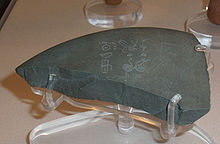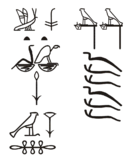Weneg (King)
| Weneg (king) in hieroglyphics | |||||||
|---|---|---|---|---|---|---|---|
| Throne name |
Nisut-biti-nebti-Weneg Njswt-bjtj-nbtj-Wng King of Upper and Lower Egypt, who was owned by the two mistresses, Weneg |
||||||
| Limestone fragment with the Weneg's throne name | |||||||
Weneg (also read as Uneg ), more rarely Weneg-nebti , is the throne name of an early Egyptian king ( pharaoh ) of the 2nd dynasty , who lived in the 28th century BC. Ruled between the kings Hetepsechemui and Chasechemui . The predecessors and successors have not yet been researched, however, between Weneg and the aforementioned rulers, other kings ruled. Their number is also uncertain due to Weneg's uncertain position in the list of rulers.
A clear chronological assignment and identification is particularly difficult due to the sparse finds and contradicting references. Weneg is therefore one of the most controversial kings of the early days among Egyptologists . In addition, there is his unusual throne name, which was written with a rare character that was only temporarily used in later times for the name of a deity and whose symbolic meaning is in the dark. The contradicting references to his reign also make a more precise assessment of the person and history of Weneg difficult. It seems that he had to share the royal throne with one or more opposing kings. It is also unknown how long Weneg ruled.
Archaeological site
Locations |
Weneg's throne name is documented with a total of 11 preserved vessel inscriptions . The excavated jugs and vases are made of calcite alabaster , limestone and slate , the inscriptions were applied with black ink and subsequently burned in or engraved directly into stone . Seven vessels come from the underground tomb galleries of the pyramid necropolis of King Djoser (beginning of the 3rd dynasty ) in Saqqara . Three other vessels come from the - not publicly accessible - Mastaba S3014 (also located in Saqqara) and the origin of the eleventh object is unclear. Weneg's name has not yet been found outside of Saqqara.
About the name
Weneg's name is of not inconsiderable interest in Egyptology . The heraldic symbol that was used for his throne name is rarely found in Egyptian literature: a tightly upright, closed and pointed lotus bud with two pointed, narrow leaves near the base of the stem. This hieroglyph is known under the reading "Weneg" or "Uneg" and its symbolic meaning is unclear. The flower was long considered a symbol from the Buti script . However, the theory developed by Wolfgang Helck is controversial today. In the case of King Weneg, in three of the inscriptions at the bud height, the flower is surrounded by six vertical lines, three on either side. The meaning of these lines is also puzzling. After Weneg's death, the “Weneg flower” only appears in the so-called pyramid texts of the sixth dynasty, where it is used as the name of Weneg, the god of heaven and the dead . Weneg is addressed there as "son of Re " and is described as a "follower" of the late king.
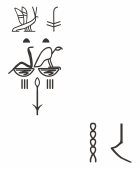
|

|

|

|
| Vessel inscription No. 104 with only partially preserved inscription, the Weneg flower has six lines. | Vessel inscription no. 53c depicting the royal barque Hor-seba-taui ("Horus, star of the two countries"). | Vessel inscription no. 105 depicting the king's barque A'a ("The Greatest"). | Vessel inscription no. 106 depicting the king's barque Sema'a-taui ("Wild Bull"). |
identity
Since Weneg's name has so far only been passed down as a throne name, Egyptologists have difficulties connecting the ruler with the already known Horus names of the second dynasty. This makes a complete and error-free historical reconstruction difficult. Therefore, there are numerous equation interpretations. The individual theories are not uncontested.
Weneg is identical to Hor-Nebre
Egyptologist Jochem Kahl identifies Weneg with the contemporary documented and much-discussed Horus name " Nebre ". He sees the volcanic stone fragment BM EA 35556 and its vessel engraving as the key to the solution in connection with the equation of “Nebre” and “Weneg”. Both names were originally next to each other on the fragment, but were later overwritten. In the center of the inscription, the Nesutbitj-Nebti name of Ninetjer , the third ruler of the 2nd dynasty , is legible today . The hieroglyphs , with which Ninetjer's name is written, face the representation of the palace " Hut-sa-ha " of Nebre on the right side and are thus mirror-inverted. The representation of the palace and the name of the Nebre show partial destruction from abrasion. Kahl suspects that the already existing hieroglyph of the “Weneg flower” should be ground away and overwritten with the characters for the name “Ninetjer”. From this Kahl concludes an equation of the names "Weneg" and "Nebre". The reasons why the Horus name of Nebre should possibly also be deleted remain unclear. Kahl points out, however, that at least four of Weneg's names were added "on the shave", so Weneg himself had the names of his predecessors overwritten. As a further argument, he relies on the assumption that the name of Hor-Nebre can be read as "Raneb" (in German "Ra is my Lord") and that the deity Weneg was worshiped as the "son of Ra". Since he derived a common ground with regard to a beginning sun cult, he linked the names "Raneb" and "Weneg" with one another. As a third argument for equating the names "Nebre" and "Weneg", Kahl cites the so-called " gold name ", which appears in archaic form as early as the 1st dynasty and was later used as an honorary title for Ra. Kahl therefore assumes that Ra must have been a prominent deity as early as the 1st Dynasty.
Kahl's equation of the names "Nebre" and "Weneg" has meanwhile been welcomed by a large part of Egyptology. The theories about the early dynastic existence of a sun god "Ra" are still viewed with skepticism. Ben Suelzle points out that the title "The Golden One" was also used as an honorific salutation for other deities, such as for Horus under King Qaa (1st Dynasty), where Horus is titled as "Golden One of the Godheads". Or for the crown goddesses Nekhbet and Wadjet under King Khasekhemwy (whose Nebtiname was "Coronation of the two powers of the Two Ladies, her body is made of gold"). As a third example, Suelzle cites the god Seth , who was also referred to as "The Golden" under King Peribsen . “The golden one” could therefore stand for practically every deity in Egypt. A gold name is therefore not a compelling indication of a worship of a "sun god Ra" in the early dynastic epochs, especially since the kings always viewed themselves as representatives of Horus and Seth, not Ra. Stephen Quirke adds that the term "Ra" (Egyptian r3 ) for the sun only appears in the names of high officials under King Djoser. A "sun god Rê" as an independent god with his own cult has not yet been proven under Nebre, it was only introduced under King Djoser.
Weneg is identical to Hor-Sechemib-Perenmaat
Nicolas Grimal and Walter Bryan Emery are convinced that Weneg is identical to King Sechemib . This theory is based on the assumption that King Ninetjer was immediately followed by kings Sechemib and Peribsen to the throne and Weneg is identical to the Ramessid cartouche name Wadjenes , who is also given in royal lists of ancestors as the direct successor of Ninetjer. Grimal and Helck therefore equate Sechemib with Wadjenes and Peribsen with the Ramessid successor name Sened . However, the thesis is not uncontested: Since finds of clay seals with Sechemib's name in the Abyden tomb of Chasechemui , the last ruler of the 2nd dynasty, were made, Sechemib's chronological position moves very close to the end of the 2nd dynasty. But Wadjenes' name is being moved closer and closer to the beginning of this epoch, so that a temporal discrepancy comes to light. The names "Sened" and "Peribsen" are always honored separately in later sources, so that an equation of these kings is also not mandatory.
Weneg is identical to Seth-Peribsen
Wolfgang Helck and Dietrich Wildung consider it possible that Weneg is identical with King Seth-Peribsen , since they also suspect that Peribsen is to be equated with the Ramessid cartouche name Wadjenes . This explanation is based on the assumption that Peribsen's name was misinterpreted by the hieratic script (the name was read out from “Peribsen” to “Wadjenes” from improper writing).
Weneg is identical to Hor-Sa
Jürgen von Beckerath , Wolfgang Helck, Dietrich Wildung and Peter Kaplony alternatively equate Weneg with the Horus name of King Sanacht . Their explanation is based on the equation of Sanacht with the name of King Sa, which has also not been assigned with certainty . They consider the name "Sa" to be a short form of "Sanacht". Based on this equation, Wolfgang Helck suggests linking Sanacht to the name of the throne of Weneg. According to general doctrine, however, Sanacht ruled during the 3rd Dynasty , which is why Helck's proposal has so far met with skepticism.
Weneg was an independent ruler
According to other Egyptologists, Weneg is identical to the Ramessid cartouche name "Wadjenes". Winfried Barta , Bernhard Grdseloff and Iorwerth Eiddon Stephen Edwards suspect that the name “Wadjenes” is a prescription for the name “Weneg”: Ramesside scribes may have confused the hieroglyph M13B (a papyrus stem with two narrow leaves at the base) and the Weneg flower , as these are very similar in the hieratic script . The name syllable "nes" ( F20 ) in the list of kings of Saqqara could again have been a misinterpretation of the symbols N35 and S29 .
The background to these explanations are six vessel inscriptions which, like those of Weneg, come from Saqqara. The inscription "Wer-maa- Wadjesen " ( Wadjesen is really big ) appears on two of these vessels . Egyptologists such as Wolfgang Helck interpret the “Wer-maa” as a possible title of a crown prince. This interpretation in turn meets with strong skepticism in Egyptology. Jochem Kahl interprets the "Wer-maa" as the title of the high priest of Re and reads the name as "Ni-su-Wadj". The name "Wadjesen" always appears on four of the vessel fragments next to the depiction of the Sedfest , which was celebrated either every six years during the Sokar festival or for the first time in the 30th year of the reign and then celebrated every three years. A thirty-year period, however, would be in contradiction to Wadjene's weak contemporary and archaeologically documented presence. This is one of the main reasons for debate among Egyptologists. The arrangement of the hieroglyphs on the fragments also raises questions. The characters M13 and S29 are next to each other and together close to the character N35 . From this constellation , a reading as “Wadjesen” is more likely.

"Weneg" became "Wadjenes" due to a reading, which was later read as "Wet-las" in Coptic . Manetho translated this as "Outlas", which was abbreviated to "Tlas" in later copies. Manetho names Wadjenes as the fourth ruler of the second dynasty and ascribes 17 years of reign to him.
Chronological assignment
Due to the archaeological finds, it is at least certain that Weneg must have ruled during the second dynasty. But since his Horus name is unknown, his direct predecessor and his direct successor are also unidentified. If Weneg is identical with the Ramessid ancestral king Wadjenes (as still favored by some Egyptologists), King Ninetjer was his predecessor and King Sened was his successor.
Reign
If Weneg was an independent ruler and King Ninetjer actually succeeded the throne, it can be assumed that he was confronted with domestic political problems at the beginning of his reign. Because the name "Weneg" has not yet been used in Upper Egypt , Egyptologists such as Nicolas Grimal and Wolfgang Helck assume that Weneg's power was limited to Lower Egypt and that he had to share the Egyptian Empire with another ruler.
Due to the many possible interpretations that result from the sometimes contradicting finds, Egyptology regards the 2nd dynasty as particularly problematic. The background to this is the equally uncertain find situation regarding the change from the first to the second dynasty. At the time of King Qaa's death, there appears to have been a quarrel over the throne, culminating in the looting of the royal cemetery at Abydos. The founder of the 2nd dynasty, King Hetepsechemui, moved his grave to Saqqara, his immediate successors, Nebre and Ninetjer, did the same.
To this day, Egyptologists and historians are investigating the more precise causes and circumstances that could have led to a division of the empire. Wolfgang Helck, Nicolas Grimal , Hermann A. Schlögl, Francesco Tiradritti and Toby Wilkinson are convinced that King Ninetjer , third regent of the 2nd dynasty, divided the Egyptian empire into two independent empires and had two of his sons or selected heirs to the throne rule synchronously. They assume that by this time Egypt's administrative apparatus had become too large and complex and threatened to collapse. To prevent this and to facilitate the administration of the state, Egypt was divided and two rulers were installed at the same time.
However, it is unknown when exactly Egypt was divided into two independent halves. In this context, Percy E. Newberry points out that there may have been domestic political tensions under King Ninetjer. Newberry refers to the inscription on the Palermostein , a black basalt plaque that lists the names and annual entries of all rulers from the 1st Dynasty to the reign of King Neferirkare ( 5th Dynasty ) on the front and back . The Palermostein handed down the government years 7 to 21 for Ninetjer. In the 14th year of the reign, the ruler is said to have destroyed the cities of Shem-Re and Ha , if one of two possible interpretations applies . Dmitri B. Proussakov also throws in that from the 12th year of reign the ceremony "Appearance of the King" is no longer introduced with the full throne name (Nisut-biti) , but only referred to as the "Appearance of the King of Lower Egypt". Proussakov interprets this as an indication that Ninetjer only had limited power.
In contrast, Barbara Bell suspected a prolonged drought among Ninetjer that led to famine . In order to be able to secure the supply of the Egyptian population, the kingdom was divided until the drought and the associated famine ended. Bell justified her thesis with the records of the Nile flood heights below the annual window of the Palermostein. According to their interpretation, the Palermostein recorded unusually low levels of the Nile at the time of King Ninetjer. Today this theory has been refuted. Historians like Stephan Seidlmayer have recalculated and corrected Bell's estimates. Barbara Bell may not have considered that the Palermostein only shows the levels of the Nile in the region around Memphis and ignores the levels along the rest of the course of the Nile. Stephan Seidlmayer was able to prove that the Nile flood heights in Ninetjer's time were balanced and comparatively high. A drought as a reason for dividing the empire can therefore now be ruled out. The actual reason for a division of the empire remains unclear for the time being.
Counter rulers
Wolfgang Helck, Toby Wilkinson, Francesco Tiradritti, Hermann A. Schlögl, Walter B. Emery and Nicolas Grimal are convinced that Weneg had to share the throne with other rulers. The situation in which the vessels were found indicates that Weneg only ruled in Lower Egypt, as such objects have not yet been discovered outside of the Saqqara cemetery. That is why there is intensive research into who could have ruled in neighboring Upper Egypt at that time.
Another problem is the many names of Horus and Nebtin that appear in inscriptions on stone vessels and on clay seals. These were discovered in the Great Western Gallery in the necropolis of King Djoser ( 3rd Dynasty ) in Saqqara and in Abydos. The inscriptions mention kings like Sechemib-Perenmaat, Sa, Nubnefer , Seneferka , Horus Ba and " Vogel ". With the exception of the vessels of the Sechemib, the number of objects for the rest of the rulers is very limited. Hence, Egyptologists and historians assume that these rulers - with the exception of Sechemib - only ruled for a very short time. King Seneferka may be identical to or a short-term successor to King Qaa . But kings like Nubnefer, Ba and "Vogel" remain a mystery. Their names have so far only been discovered in Saqqara.
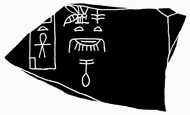
|
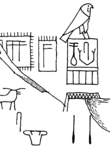
|

|

|
| Slate shard with the Nesutbiti name Nubnefer | Slate shard with the name of Horus S (e) nefer-ka | Basalt sherd with the Horus name Ba | Alabaster shard with the Horus name "bird" |
dig
Weneg's grave is unknown. Francesco Tiradritti and Wolfgang Helck suggest the Great Western Galleries in Djoser's tomb as a possible final resting place. However, Tiradritti also refers to the tomb of Merire from the 18th dynasty . Its underground galleries turned out to be mostly usurped grave corridors of a burial from the 2nd dynasty. However, this tomb may also have been intended for King Sened.
literature
General literature
- Darrell D. Baker: The Encyclopedia of the Egyptian Pharaohs. Vol. 1: Predynastic to the Twentieth Dynasty (3300-1069 BC). Bannerstone Press, London 2008, ISBN 978-0-9774094-4-0 , pp. 362-365.
- Jürgen von Beckerath : Handbook of the Egyptian king names (= Munich Egyptological studies. Vol. 49). 2nd improved and enlarged edition. von Zabern, Mainz 1999, ISBN 3-8053-2591-6 , pp. 44-45.
- Michael Rice: Who's Who in Ancient Egypt. Routledge, London et al. 2001, ISBN 0-415-15449-9 , pp. 72, 134 & 172.
- Thomas Schneider : Lexicon of the Pharaohs. Albatros, Düsseldorf 2002, ISBN 3-491-96053-3 , p. 195.
Special literature
- Laurel Bestock: The Development of Royal Funerary Cult at Abydos. Two Funerary Enclosures from the Reign of Aha (= Menes. Vol. 6). Harrassowitz, Wiesbaden 2009, ISBN 978-3-447-05838-4 .
- Susanne Bickel: The connection between the worldview and the state: Aspects of politics and religion in Egypt. In: Reinhard Gregor Kratz , Hermann Spieckermann (Ed.): Images of Gods, Images of God, Images of the World. Polytheism and Monotheism in the Ancient World. Volume 1: Egypt, Mesopotamia, Persia, Asia Minor, Syria, Palestine (= research on the Old Testament. 2nd row, Vol. 17). Mohr Siebeck, Ulmen 2006, ISBN 3-16-148673-0 , pp. 79-99.
- IES Edwards (Ed.): Early History of the Middle East (= The Cambridge Ancient History. Vol. 1-2). 2 volumes = 3 parts. 3rd edition. Cambridge University Press, Cambridge 1970, ISBN 0-521-07791-5 .
- Walter B. Emery : Egypt. Fourier, Wiesbaden 1964, ISBN 3-921695-39-2 .
- Nicolas Grimal: A History of Ancient Egypt. Wiley & Blackwell, Oxford (UK) 1994, ISBN 0-631-19396-0 .
- Wolfgang Helck : Investigations on the thinite period (= Egyptological treatises. Vol. 45). Harrassowitz, Wiesbaden 1987, ISBN 3-447-02677-4 .
- Wolfgang Helck: Investigations into Manetho and the Egyptian king lists (= investigations into the history and antiquity of Egypt , vol. 18). Akademie Verlag, Berlin 1956
- Erik Hornung : The One and the Many. Egyptian ideas of God. 2nd unchanged edition. Scientific Book Society, Darmstadt 1973, ISBN 3-534-05051-7 .
- Jochen Kahl : Inscriptional Evidence for the Relative Chronology of Dyn. 0–2. In: Erik Hornung, Rolf Krauss, David A. Warburton (eds.): Ancient Egyptian Chronology (= Handbook of Oriental studies. Section One. The Near and Middle East. Volume 83). Brill, Leiden / Boston 2006, ISBN 978-90-04-11385-5 , pp. 94-115 ( online ).
- Jochem Kahl: "Ra is my Lord". Searching for the Rise of the Sun God at the Dawn of Egyptian history (= Menes. Vol. 1). Harrassowitz, Wiesbaden 2007, ISBN 978-3-447-05540-6 .
- Peter Kaplony: Small contributions to the inscriptions of the early Egyptian period . In: Wolfgang Helck: Lexicon of Egyptology . Vol. 3, Harrassowitz, Wiesbaden 1986, ISBN 3-447-02662-6 .
- Peter Kaplony : The inscriptions of the early Egyptian period (= Ägyptologische Abhandlungen. Vol. 8, 3, ISSN 1614-6379 ). Volume 3, Harrassowitz, Wiesbaden 1963.
- Peter Kaplony: "He is a favorite of women" - a "new" king and a new theory about the crown prince and the goddesses of the state (crown goddesses) of the 1st / 2nd. Dynasty. In: Egypt and Levant. Vol. 13, 2006, ISSN 1015-5104 , pp. 107-126, doi : 10.1553 / AE and L13 .
- Ludwig D. Morenz : Image letters and symbolic signs: The development of writing in the high culture of ancient Egypt . (= Orbis Biblicus et Orientalis 205). Friborg 2004, ISBN 3-7278-1486-1 .
- PE Newberry : The Seth Rebellion of the 2nd Dynasty. In: Ancient Egypt. Vol. 7, 1922, ZDB -ID 216160-6 , pp. 40-46.
- Jean-Pierre Pätznik: The seal unrolling and cylinder seals of the city of Elephantine in the 3rd millennium BC. Securing evidence of an archaeological artifact (= BAR, International Series. Bd. 1339). Archaeopress, Oxford 2005, ISBN 1-84171-685-5 (also: Heidelberg, Univ., Diss., 1999).
- Dmitri B. Proussakov: Early Dynastic Egypt: A socio-environmental / anthropological hypothesis of "Unification". In: Leonid E. Grinin (Ed.): The Early state, its Alternatives and Analogues. Uchitel Publishing House, Volgograd 2004, ISBN 5-7057-0547-6 , pp. 139-180.
- Gay Robins: The Art of Ancient Egypt. Harvard University Press, Cambridge MA 1997, ISBN 0-674-04660-9 .
- Anna Maria Donadoni Roveri, Francesco Tiradritti (ed.): Kemet. All Sorgenti Del Tempo. Electa, Milano 1998, ISBN 88-435-6042-5 .
- Hermann A. Schlögl : Ancient Egypt. History and culture from the early days to Cleopatra. Beck, Munich 2006, ISBN 3-406-54988-8 .
- Christian E. Schulz: Writing implements and scribes in the 0th to 3rd dynasty. Grin, Munich 2007, ISBN 978-3-638-63909-5 .
- Stephan Seidlmayer : Historic and modern Nile stands. Investigations into the level readings of the Nile from the earliest times to the present (= Achet - Schriften zur Ägyptologie. Vol. A, 1). Achet-Verlag, Berlin 2001, ISBN 3-9803730-8-8 .
- Alan J. Spencer: Early Egypt. The Rise of Civilization in the Nile Valley. British Museum Press, London 1993, ISBN 0-7141-0974-6 .
- Herman te Velde : Seth, God of Confusion. A Study of his Role in Egyptian Mythology and Religion (= Problems of Egyptology. Vol. 6). Reprint with come corrections. Brill, Leiden 1977, ISBN 90-04-05402-2 (also: Groningen, Univ., Diss., 1967).
- Dietrich Wildung : The role of Egyptian kings in the consciousness of their posterity. Volume 1: Posthumous sources on the kings of the first four dynasties (= Munich Egyptological studies. Vol. 17, ZDB -ID 500317-9 ). B. Hessling, Berlin 1969 (at the same time: Diss., Univ. Munich).
- Toby AH Wilkinson: Early Dynastic Egypt. Strategies, Society and Security. Routledge, London et al. 1999, ISBN 0-415-18633-1 .
- Toby AH Wilkinson: The Rise and Fall of Ancient Egypt. The History of a Civilization from 3000 BC to Cleopatra. Bloomsbury, London et al. 2011, ISBN 978-1-4088-1002-6 .
Individual evidence
- ^ Peter Kaplony: Small contributions to the inscriptions of the Egyptian early period. Item no.27.
- ↑ a b Bernhard Grdseloff: King Uneg . In: Annales du Service des Antiquités de l'Égypte. No. 44, 1944, pp. 279-306.
- ↑ a b c Winfried Barta in: Journal for Egyptian language and antiquity. No.108. Akademie Verlag, Berlin 1981, ISSN 0044-216X , pp. 20-21.
- ^ A b c Iorwerth Eiddon Stephen Edwards: The Cambridge ancient history. Vol. 1, Plate 2: Early history of the Middle East , 3rd reprint. Cambridge University Press, Cambridge 2006, ISBN 0-521-07791-5 , p. 31.
- ↑ a b Jochem Kahl: The system of the Egyptian hieroglyphic writing in the 0. – 3. Dynasty. In: Göttingen Orient Research. Vol. IV. 1994, pp. 354-355.
- ↑ Wolfgang Helck: Investigations on the thinite age. Egyptological treatises. Vol. 45, Harrassowitz, Wiesbaden 1987, ISBN 3-447-02677-4 , p. 142.
- ↑ Ludwig David Morenz: Image letters and symbolic signs . P. 30.
- ^ Pierre Lacau, Jean-Philippe Lauer : Fouilles à Saqqarah. La pyramid à degrés. IV. Inscriptions gravées on the vases. Cairo 1959; Ref. 104.
- ^ Pierre Lacau, Jean-Philippe Lauer: Fouilles à Saqqarah. La pyramid à degrés. IV. Inscriptions gravées on the vases. Cairo 1959; Ref. 53c.
- ^ Pierre Lacau, Jean-Philippe Lauer: Fouilles à Saqqarah. La pyramid à degrés. IV. Inscriptions gravées on the vases. Cairo 1959; Ref. 105.
- ^ Pierre Lacau, Jean-Philippe Lauer: Fouilles à Saqqarah. La pyramid à degrés. IV. Inscriptions gravées on the vases. Cairo 1959; Ref. 105.
- ↑ Jochem Kahl: Ra is my Lord. Wiesbaden 2007, p. 8.
- ↑ Jochem Kahl: Ra is my Lord. Wiesbaden 2007, pp. 4-14.
- ↑ see for example Stephen Quirkes book review of Jochem Kahl's "Ra is my Lord". In: Journal of Egyptian Archeology. 95. Egypt Exploration Society, London 2009, ISSN 0307-5133 , pp. 299-300.
- ↑ see also Hartwig Altenmüller's book review on Jochem Kahl's "Ra is my Lord". In: Lingua Aegyptia - Studia monographica. Volume 16. Seminar for Egyptology and Coptology , Göttingen 2008, pp. 331–333.
- ↑ see Ben Suelzle's book review by Jochem Kahl: "Ra is my Lord." In: Eras. 10th edition, November 2008, Monash University Press, Melbourne 2008, ISSN 1445-5218 , pp. 2 & 3, PDF version ( Memento of March 28, 2012 in the Internet Archive ) (English).
- ↑ Steven Quirke: Ancient Egyptian Religions. P. 22.
- ^ Walter Bryan Emery: Egypt. Early history and culture. P. 105.
- ^ Gunter Dreyer: Umm el-Qaab. Follow-up examinations in the early royal cemetery: 13./14./15. Preliminary report. In: Communications of the German Archaeological Institute, Cairo Department No. 59. German Archaeological Institute, Orient Department (ed.). de Gruyter, Berlin 2003, p. 115, Figure 42b.
- ↑ Dietrich Wildung: The role of Egyptian kings in the consciousness of their posterity. Volume 1. 1969, pp. 45-47.
- ↑ Wolfgang Helck: Investigations into Manetho and the Egyptian king lists. 1956, pp. 13-14.
- ↑ Jürgen von Beckerath: Handbook of the Egyptian king names. Pp. 49, 283 & 293.
- ↑ Wolfgang Helck: Investigations on the thinite age. P. 20f
- ^ Pierre Lacau, Jean-Philippe Lauer: Fouilles à Saqqarah. La pyramid à degrés. V. Inscriptions à l'encre sur les vases. Cairo 1959, p. 12; Fig. 20.
- ^ Bernhard Grdseloff in: Annales du Service des Antiquités de l'Égypte No. 44, 1944, pp. 279–306.
- ↑ a b Winfried Barta: Journal for Egyptian language and antiquity. No. 108. Akademie Verlag, Berlin 1981, ISSN 0044-216X , p. 11.
- ^ Pierre Lacau, Jean-Philippe Lauer: Fouilles à Saqqarah. La pyramid à degrés. IV. Inscriptions gravées on the vases. Cairo 1959, plate 19, no. 105, plate 20, no. 101-107.
- ↑ Jochem Kahl: Ra is my Lord. Wiesbaden 2007, p. 50.
- ^ IES Edwards: The Cambridge ancient history . P. 31.
- ↑ Histoire de l'Égypte ancienne. Fayard, Paris 1988, ISBN 2-213-02191-0 , p. 68
- ^ Walter Bryan Emery: Great tombs of the First Dynasty (= Excavations at Saqqara. Vol. 3). Government Press, London 1958, pp. 28-31.
- ↑ Peter Kaplony: "He is a favorite of women". 2006, pp. 126-127.
- ↑ a b c d Anna Maria Donadoni Roveri, Francesco Tiradritti in: Kemet . 1998, pp. 80-85
- ^ Nicolas Grimal: A History of Ancient Egypt . 1994, pp. 55-56.
- ^ Pierre Lacau, Jean-Philippe Lauer: Fouilles à Saqqarah. La pyramid à degrés. IV. Inscriptions gravées on the vases. Cairo 1959; Ref. 107.
- ^ Pierre Lacau, Jean-Philippe Lauer: Fouilles à Saqqarah. La pyramid à degrés. IV. Inscriptions gravées on the vases. Cairo 1959; Ref. 53a.
- ^ Pierre Lacau, Jean-Philippe Lauer: Fouilles à Saqqarah. La pyramid à degrés. IV. Inscriptions gravées on the vases. Cairo 1959; Ref. 53b.
- ^ Pierre Lacau, Jean-Philippe Lauer: Fouilles à Saqqarah. La pyramid à degrés. IV. Inscriptions gravées on the vases. Cairo 1959; Ref. 101.
- ↑ Werner Kaiser: On the naming of Sened and Peribsen in Saqqara B3. In: Göttinger Miscellen . (GM). No. 122, 1991, ISSN 0344-385X , pp. 49-55.
- ↑ Darrell D. Baker: The Encyclopedia of the Egyptian Pharaohs . Volume 1, 2008, pp. 362-364.
- ↑ Dmitri B. Proussakov: Early Dynastic Egypt. 2004, p. 156ff.
- ↑ Barbara Bell: The Oldest Records of the Nile Floods. In: Geographical Journal. Vol. 136, No. 4, 1970, ISSN 0016-7398 , pp. 569-573.
- ↑ Hans Goedike: King Ḥwḏf3? In: Journal of Egypt Archeology. Vol. 42, 1956, ISSN 0307-5133 , pp. 50-53.
- ↑ Stephan Seidlmayer: Historic and modern Nile stands. 2001, pp. 87-89.
- ^ A b c d e Toby AH Wilkinson: Early Dynastic Egypt . 1999, pp. 75-76 & 89-91.
- ^ A b Nicolas Grimal: A History of Ancient Egypt. 1994, p. 55.
- ^ Hermann A. Schlögl: The old Egypt . Munich 2006, p. 78.
- ↑ Wolfgang Helck: Investigations on the thinite age . 1987, pp. 103-111.
- ^ Pierre Lacau, Jean-Philippe Lauer: Fouilles à Saqqarah. La pyramid à degrés. IV. Inscriptions gravées on the vases. Cairo 1959, property no.99.
- ^ Pierre Lacau, Jean-Philippe Lauer: Fouilles à Saqqarah. La pyramid à degrés. IV. Inscriptions gravées on the vases. Cairo 1959, property no.86.
- ^ Pierre Lacau, Jean-Philippe Lauer: Fouilles à Saqqarah. La pyramid à degrés. IV. Inscriptions gravées on the vases. Cairo 1959, property no.97.
- ^ Pierre Lacau, Jean-Philippe Lauer: Fouilles à Saqqarah. La pyramid à degrés. IV. Inscriptions gravées on the vases. Cairo 1959, object no.4.
| predecessor | Office | successor |
|---|---|---|
| Ninetjer |
King of Egypt 2nd Dynasty |
Sened |
| personal data | |
|---|---|
| SURNAME | Weneg |
| ALTERNATIVE NAMES | Uneg; Weneg-nebti |
| BRIEF DESCRIPTION | Egyptian Pharaoh of the 2nd Dynasty |
| DATE OF BIRTH | before 2767 BC Chr. |
| DATE OF DEATH | around 2760 BC Chr. |


